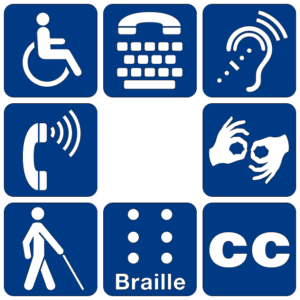EU Web Accessibility Laws and Policies There are 3 main EU web accessibility laws and…

New Zealand Web Accessibility Laws and Policies
Review of New Zealand Web Accessibility Laws and Policies
Hearing and vision impairments affect over 548,000 people or 13% of New Zealand’s population. There are a number of New Zealand web accessibility laws and policies that affect the public sector, but policy is lacking for the private sector. Luckily, many organizations are pushing for accessibility awareness across New Zealand.
New Zealand Government Web Accessibility Standard
The New Zealand Government Web Accessibility Standard was created in 2013 to provide accessibility-specific requirements for government. Coupled with the New Zealand Government Web Usability Standard, it replaced the New Zealand Government Web Standards 2.0.
This standard for New Zealand web accessibility contains one principal requirement that each applicable web page must meet all five of the WCAG 2.0 conformance requirements.
WCAG 2.0 conformance requirements
- Conformance Level — To meet this Standard, each web page must satisfy all of the Level A and Level AA Success Criteria. For example, checkpoint 1.2.2 requires synchronous captions for all multimedia as a level A success criteria factor.
- Full pages — Only full pages can conform to WCAG Success Criteria. If part of a web page is excluded from the assessment, conformance cannot be achieved for that page.
- Complete processes — For web pages that are part of a process, all of the web pages that are part of that process must conform at the specified conformance level.
- Only Accessibility-Supported Ways of Using Technologies — Technologies that are relied upon to meet WCAG:
- Are used in ways that are interoperable with users’ assistive technology
- Are supported in a widely-distributed and accessibility-supported user agent or plug-in, or in an accessibility-supported user agent that is available for download/purchase in a way that does not cost a person with a disability any more than a person without a disability and is as easy to find and obtain for a person with a disability as it is for a person without disabilities.
- For now, this means that content delivered in PDF or Flash must be accompanied by an accessible alternative
- Non-Interference — Technologies that are not relied on to meet WCAG do not interfere with users’ ability to access the rest of the page. Nor does the page as a whole fail to conform if a technology that is not relied on is turned on or off, or is not supported by, the user’s browser or assistive technology
This requirement was phased in over the course of four years. By July 1, 2017, all web pages, including internal facing pages that have been created, redesigned, or redeveloped since July 1, 2014, and all public pages must conform to the Standard.
New Zealand Government Web Usability Standard
 The New Zealand Government Web Usability Standard was created to establish a set of requirements that ensure government websites are easy to use and interact with. These requirements cover various areas, including accessibility.
The New Zealand Government Web Usability Standard was created to establish a set of requirements that ensure government websites are easy to use and interact with. These requirements cover various areas, including accessibility.
The Standard requires all Public Service departments and Non-Public Service departments in the State Services to create accessible websites. The requirements in this standard only relate to publicly available websites and web pages that contain printable web pages and/or links to a non-HTML file.
While the accessibility-specific requirements are addressed in the Web Accessibility Standard, this standard sets additional requirements for websites and certain web pages. The Standard contains requirements for six items:
- Home page
- Contact Information
- Copyright
- Privacy
- Links to non-HTML files
- Printable web pages
These requirements can be read in full by visiting the web toolkit here.
New Zealand Bill of Rights Act 1990 and Human Rights Act 1993
It has been interpreted that the government is obligated under the New Zealand Bill of Rights Act and the Human Rights Act to reasonably accommodate disabled people.
The Bill of Rights applies to the government of New Zealand and states:
Everyone has the right to freedom from discrimination on the grounds of discrimination in the Human Rights Act 1993.
The grounds for discrimination in the Human Rights Act are as follows: the government is prohibited from discriminating based on a disability, which includes:
- Physical disability or impairment
- Physical illness
- Psychiatric illness
- Intellectual or psychological disability or impairment
- Any other loss or abnormality of psychological, physiological, or anatomical structure or function
- Reliance on a guide dog, wheelchair, or other remedial means
- The presence in the body of organisms capable of causing illness
Ratification of the UN Convention on Rights of Persons with Disabilities
In 2009, New Zealand ratified the UNCRPD, an international treaty that when adopted obligates the country to implement legislation that provides for accessibility.
This treaty states that people with disabilities should be able to live independently and participate fully in all aspects of life. There are two articles that relate specifically to web accessibility.
Article 9 requires States Parties to take appropriate measures to ensure that people with disabilities have equal access to information and communications technologies, among other facilities and services open or provided to the public.
Article 21 states that States Parties must ensure that people with disabilities can exercise their right to freedom of expression and opinion. This includes the freedom to seek, receive and impart information and ideas on an equal basis with others through any form of communication of their choice.
New Zealand Disability Strategy
The New Zealand Disability Strategy was created to help New Zealand become a more inclusive society, free of barriers to people with disabilities. It sets forth a ten-year plan for 2016-2026 for New Zealand web accessibility, among other forms of accessibility.
The strategy is made up of 8 different outcomes ranging from education and health to leadership and employment. Outcome 5 provides a strategy for accessibility. It is made up of various action items that include:
- Increase accessibility of government information
- Investigate opportunities for technology
- Develop framework for understanding costs of disability
- Implement the accessibility plan – public buildings
- Understand the impact of disability on housing needs
Conclusion
 Various New Zealand web accessibility laws and policies apply to the government, but there are none that require accessibility for private sector organizations. With one in four New Zealanders living with a disability, there is more work to be done.
Various New Zealand web accessibility laws and policies apply to the government, but there are none that require accessibility for private sector organizations. With one in four New Zealanders living with a disability, there is more work to be done.
The Captioning Working Group was created to improve the level of captioning on public broadcasting stations. New Zealand’s rate of public broadcasting captioning is available at less than 25% over a 24-hour period, compared to approximately 85% in Australia and 100% in the United States and United Kingdom.
This low level of captioning denies access to basic information for people who are Deaf and Hard of Hearing, as well as and breaches Article 9 of the UNCRPD. The Captioning Working Group is raising awareness with the Caption It campaign, which you can join on social media by following #CaptionItNZ.
Additionally, NZ On Air is making strides by investing in local TV, radio, and digital broadcasting. NZ on Air fully funds Access Services to provide captioning and audio description services for hearing or vision-impaired TVNZ and TV3 audiences.
With more awareness about accessibility issues, more New Zealanders will receive equal access to online information and technologies. Stay tuned for updates to New Zealand web accessibility laws and policies.



